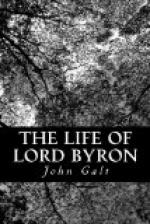Proceeding briskly from this forsaken and dead city, I arrived in the course of about half an hour at a coffee-house on the banks of a small stream, where I partook of some refreshment in the shade of three or four trees, on which several storks were conjugally building their nests. While resting there, I became interested in their work, and observed, that when any of their acquaintances happened to fly past with a stick, they chattered a sort of How-d’ye-do to one another. This civility was so uniformly and reciprocally performed, that the politeness of the stork may be regarded as even less disputable than its piety.
The road from that coffee-house lies for a mile or two along the side of a marshy lake, the environs of which are equally dreary and barren; an extensive plain succeeds, on which I noticed several broken columns of marble, and the evident traces of an ancient causeway, which apparently led through the water. Near the extremity of the lake was another small coffee-house, with a burial-ground and a mosque near it; and about four or five miles beyond I passed a spot, to which several Turks brought a coffinless corpse, and laid it on the grass while they silently dug a grave to receive it.
The road then ascended the hills on the south side of the plain, of which the marshy lake was the centre, and passed through a tract of country calculated to inspire only apprehension and melancholy. Not a habitation nor vestige of living man was in sight, but several cemeteries, with their dull funereal cypresses and tombstones served to show that the country had once been inhabited.
Just as the earliest stars began to twinkle I arrived at a third coffee-house on the roadside, with a little mosque before it, a spreading beech tree for travellers to recline under in the spring, and a rude shed for them in showers or the more intense sunshine of summer. Here I rested for the night, and in the morning at daybreak resumed my journey.
After a short ride I reached the borders of the plain of Ephesus, across which I passed along a road rudely constructed, and raised above the marsh, consisting of broken pillars, entablatures, and inscriptions, at the end of which two other paths diverge; one strikes off to the left, and leads over the Cayster by a bridge above the castle of Aiasaluk—the other, leading to the right, or west, goes directly to Scala Nuova, the ancient Neapolis. By the latter Byron and his friend proceeded towards the ferry, which they crossed, and where they found the river about the size of the Cam at Cambridge, but more rapid and deeper. They then rode up the south bank, and about three o’clock in the afternoon arrived at Aiasaluk, the miserable village which now represents the city of Ephesus.
Having put up their beds in a mean khan, the only one in the town, they partook of some cold provisions which they had brought with them on a stone seat by the side of a fountain, on an open green near to a mosque, shaded with tall cypresses. During their repast a young Turk approached the fountain, and after washing his feet and hands, mounted a flat stone, placed evidently for the purpose on the top of the wall surrounding the mosque, and devoutly said his prayers, totally regardless of their appearance and operations.




